Lecture 5: Advanced Visualization and Other Data Sources
In Lecture 2, we saw that visualization using ggplot could provide important insights into large datasets. Today, we will learn more about ggplot and use what we have learned to study the relationship between batting averages in consecutive seasons.
Visualizing the Diving Dataset
In this course, we will be using the package ggplot2 for all of our
data visualization. The gg stands for “grammar of
graphics”, a framework for data visualization. This framework separates
the process of visualization into different components: data, aesthetic
mappings, and geometric objects. These components are then added
together (or layered) to produce the final graph. We’re going to
illustrate these components using the diving
dataset from Prof. Wyner’s lecture.
Components of a Plot
The first step in any data visualization is to tell R which tbl the
data we want to plot lives. This is done using the ggplot()
function. Notice that we are assigning the plot to a new
variable, diving_hist. Later, we will add layers
to the plot using the + operator.
Aesthetics map the data to the properties of the plot. Examples include:
x: the variable that will be on the x-axisy: the variable that will be on the y-axiscolor: the variable that categorizes data by colorshape: the variable that categorizes data by shape
You can define the aes in the ggplot call,
which will then be used for all later layers, or you can define the
aes in the geom (see below), which will only
apply to that geom. Geometric objects, or
geoms, determine the type of plot that will be created.
Examples include:
geom_point(): creates a scatterplotgeom_histogram(): creates a histogramgeom_line(): creates a linegeom_boxplot(): creates a boxplot
Putting it All Together
Let’s make a histogram of judge’s scores.

In the code above, we first overwrote diving_hist so
that is now a histogram of judges’ scores where each bin had width 0.25.
In the second line, we asked R to display this object. For
ggplot code it is very important that the + goes at the end
of a line, just like the pipe %>%
Notice that the label for the x-axis is JScore, which is the column name from the tbl. We can change the label by adding a layer.
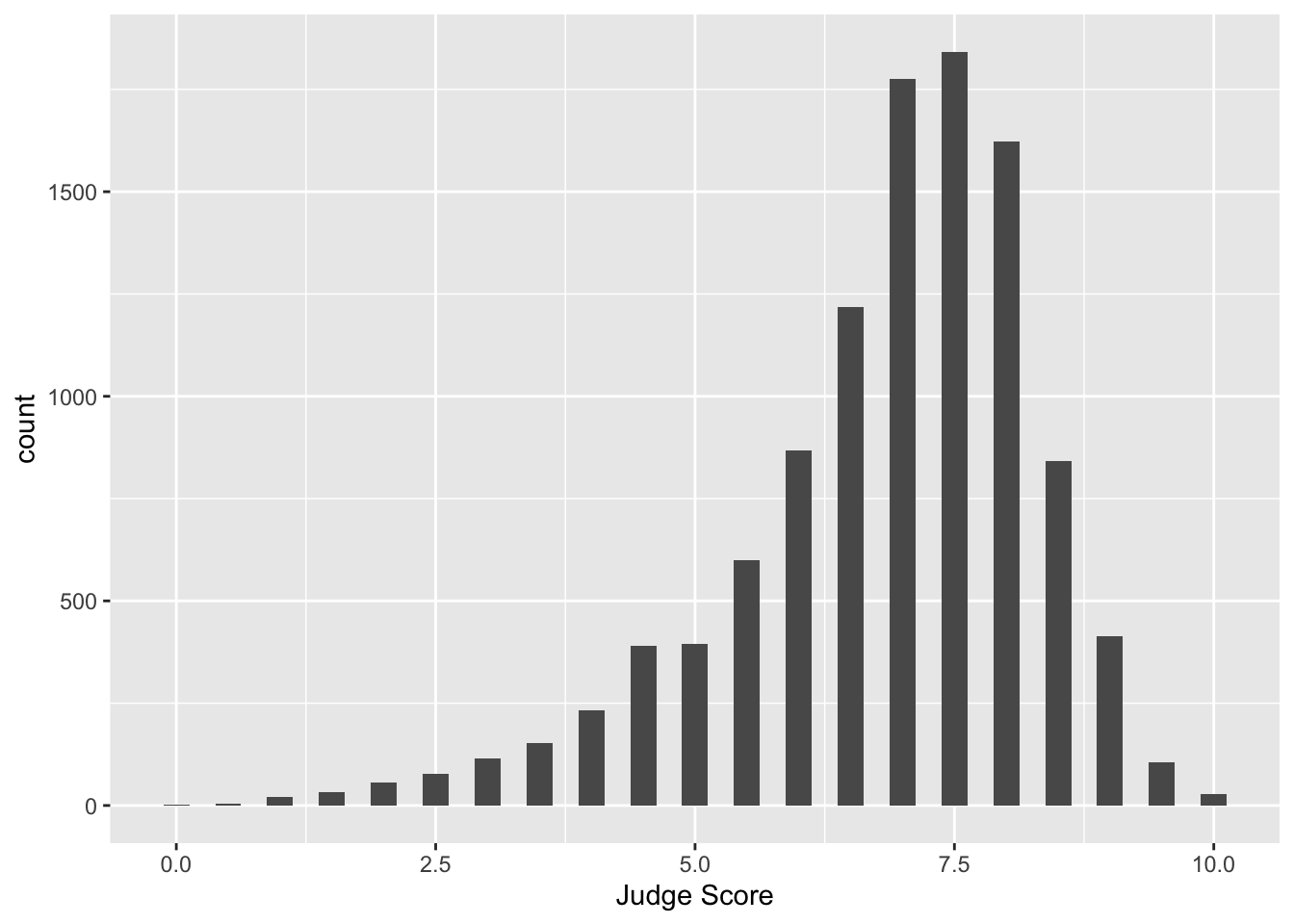
Facets
What if we want to separate the judges’ scores by country? We can use
facets. Facets allow you to separate graphs by category. We do
not need to redo our above code for the histogram - we only need to add
a facet layer to our graph hist. The first
argument of facet_wrap is the column of our dataset that
contains the category information. The second argument of
facet_wrap specifies the number of rows for which to
display the graphs.
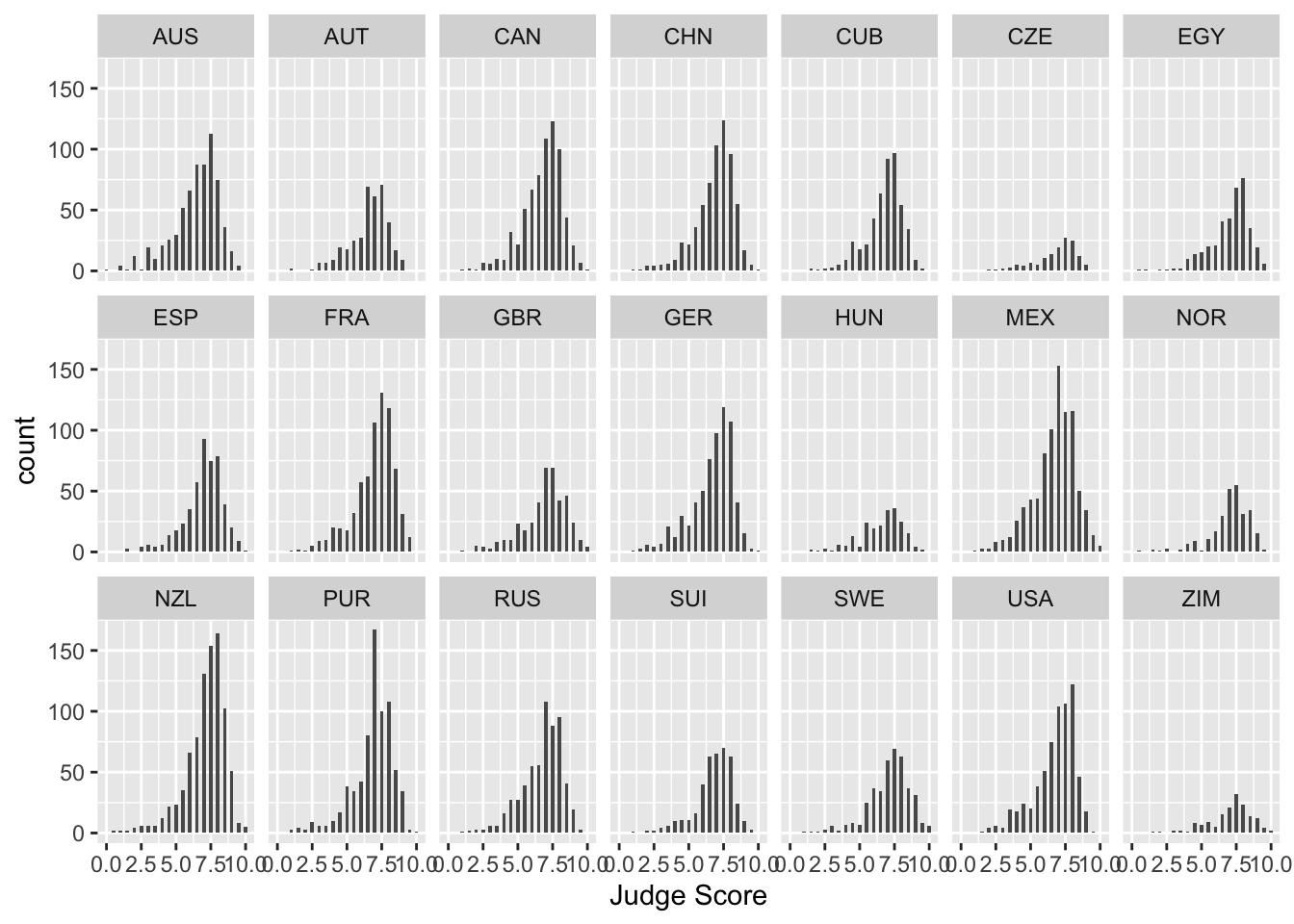
To get a sense of whether a particular country’s judges are biased,
it would be useful to add a reference line at the median score over all
judges and countries to each facet. So, we must first calculate the
overall median score, which we can do using the summarize function.
Then, we can display this median on our plots this with
geom_vline(), which adds a vertical line. We can also pass
in a custom color argument to this line so that it will easily stand out
from the rest of our values. This website provides a look at all the
build-in color arguments to R: R
colors
median_score <- diving %>%
reframe(med = median(JScore)) %>%
pull(med)
diving_hist <-
diving_hist +
geom_vline(xintercept = median_score, color = "lightcoral")
diving_hist
Note that when calculating our median_score, the
reframe function returns a tbl rather than a single value.
To “pull” out the single median value from our tbl, we use the
pull function.
Boxplots and violin plots
Boxplots are also an important visualization tool. We now create
boxplots of the judges’ scores, separated by diving round. We can also
color our boxplots according to the Round variable by
including the fill argument within the aes()
function. Note that if we included the fill argument
outside of the aes() function, we would only be able to
color all boxplots the same color (by putting fill inside
of the aesthetic, we are able to “map” the variable Round
to the fill color of the plot based on the values of
Round).
diving_box <- ggplot(data = diving) +
geom_boxplot(aes(x = Round, y = JScore, fill = Round)) +
labs(title = "Diving scores by round", x = "", y = "Judge Score", fill = "Round")
diving_box
We can also remove the unnecessary x-axis ticks and labels as the
legend on the right is sufficient. We do so using the theme
layer:
diving_box <- diving_box +
theme(axis.title.x = element_blank(), axis.text.x = element_blank(), axis.ticks.x = element_blank())
diving_box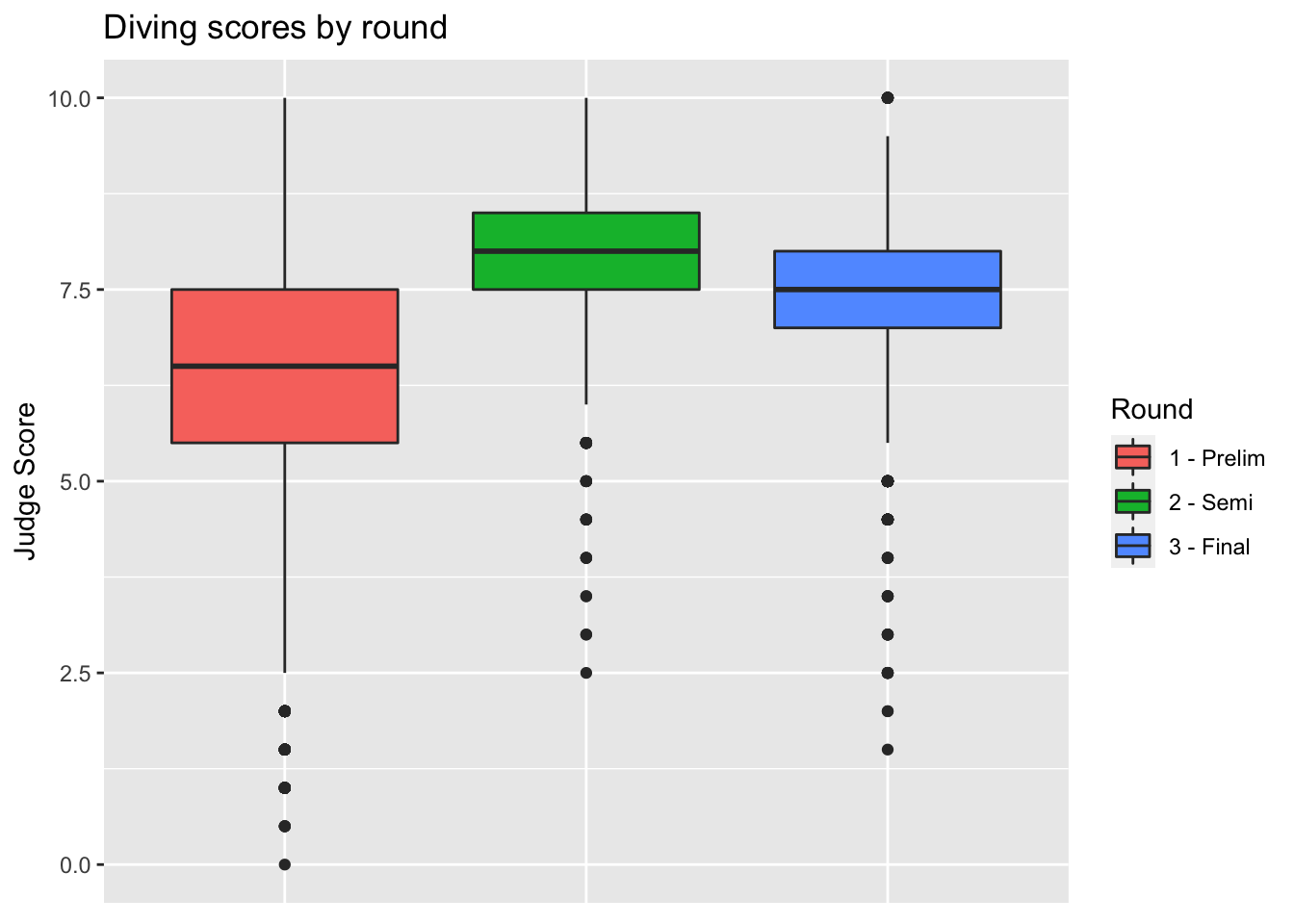
We can also plot this data as violin plots, which takes in the same
arguments as geom_boxplot but instead with
geom_violin. We can also change the “look” of our plots by
setting the theme. theme_minimal() is frequently used for a
much cleaner look.
diving_violin <- ggplot(data = diving) +
geom_violin(aes(x = Round, y = JScore, fill = Round)) +
labs(title = "Diving scores by round", x = "", y = "Judge Score", fill = "Round") +
theme_minimal()
diving_violin
We can see that the boxplots provide more information about statistical features, such as the median and quartiles, but the violin plots provide a better sense of how the data is distributed. We can see the effect of smaller rounds having more binned scores, whereas they are spread much more evenly in the first round.
Barplots
We can also create barplots using geom_bar. By mapping
fill=JCountry inside our aes(), we can map
each bar’s color to the country for that judge.
bar <- ggplot(data = diving) +
geom_bar(aes(x = JCountry, fill = JCountry)) +
labs(x = "Judge Country") +
theme_minimal() +
theme(legend.position = "none")
bar
Scatterplots
Now let’s turn back to scatterplots, which were introduced in Lecture 2. We plot judges’ score versus rank of the diver. As we expect, the higher the divers’ rank, the higher their score.
scatter_raw = ggplot(data = diving) +
geom_point(aes(x = Rank, y = JScore, color = Country)) +
labs(x = "Diver Rank", y = "Judge Score") +
theme_minimal()
scatter_raw We can see that this plot is a little messy and hard to interpret, which
may commonly happen with scatterplots when multiple rows correspond to
the same thing, such as a diver. We can improve on this visual by
grouping per diver and using
We can see that this plot is a little messy and hard to interpret, which
may commonly happen with scatterplots when multiple rows correspond to
the same thing, such as a diver. We can improve on this visual by
grouping per diver and using reframe() to calculate the
mean of the judge scores, ranks, and difficulties for each diver. We
also want to save the country for visualizations, so we use the
first() command within reframe().
diving_grouped <- diving %>%
group_by(Diver) %>%
reframe(JScore_mean = mean(JScore),
Rank_mean = mean(Rank),
Difficulty_mean = mean(Difficulty),
Country = first(Country))
head(diving_grouped) ## # A tibble: 6 × 5
## Diver JScore_mean Rank_mean Difficulty_mean Country
## <chr> <dbl> <dbl> <dbl> <chr>
## 1 ABALLI Jesus-Iory 6.61 22 3.08 CUB
## 2 AHRENS Stefan 7.29 10.6 2.74 GER
## 3 AKHMETBEKOV Damir 4.32 41 2.95 KAZ
## 4 ALCALA Maria-Jose 5.53 30 2.84 MEX
## 5 ALEKSEEVA Svetlana 6.87 16 2.37 BLR
## 6 ALLY Tony 6.92 11.3 2.79 GBRThis will allow us to plot a single point per diver, which will make the plot much easier to interpret.
scatter = ggplot(data = diving_grouped) +
geom_point(aes(x = Rank_mean, y = JScore_mean, color = Country), size = 2) +
labs(x = "Diver Rank", y = "Judge Score") +
theme_minimal()
scatter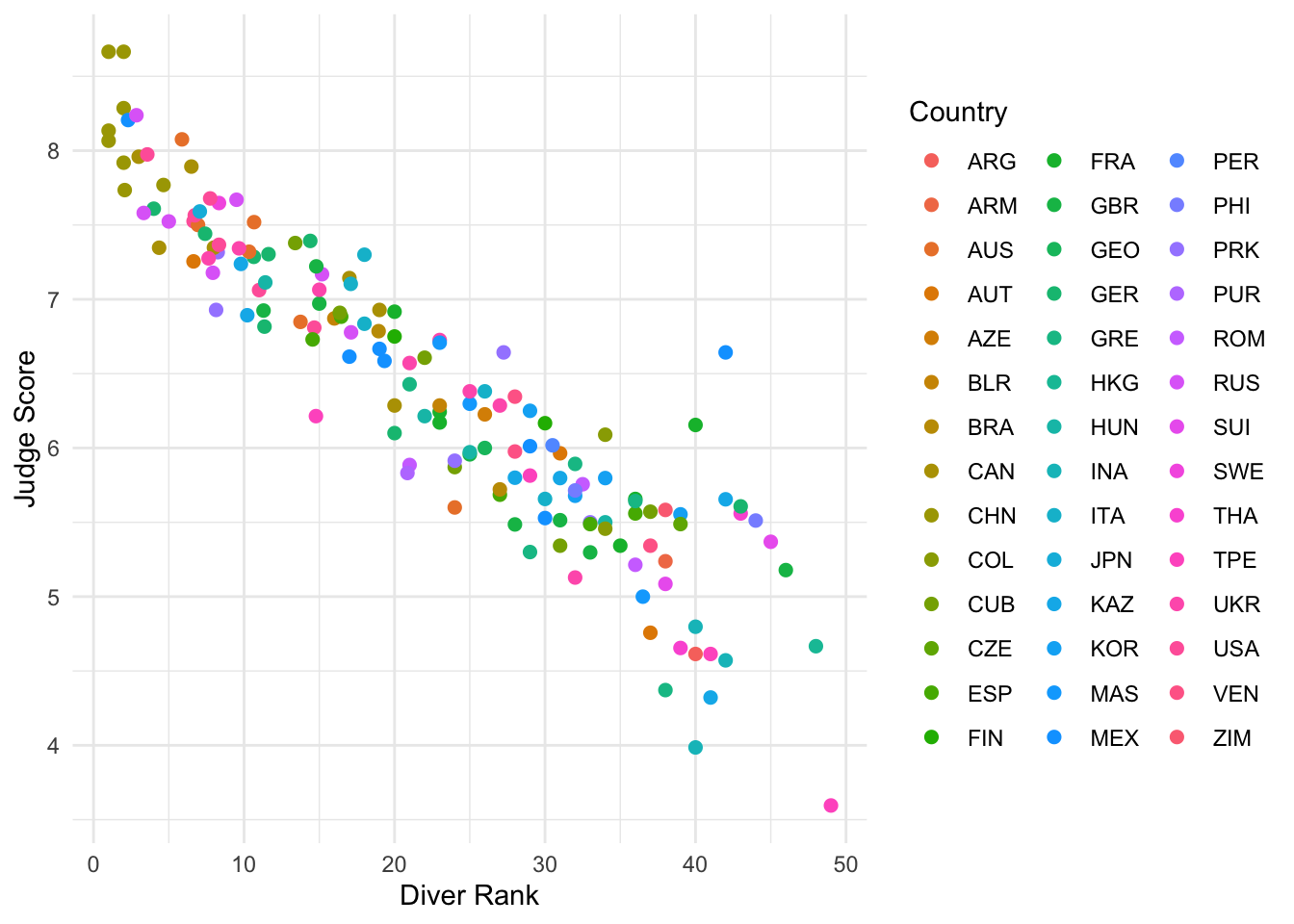 We can see here the much clearer trend between judge score and diver
rank.
We can see here the much clearer trend between judge score and diver
rank.
Lines
We can also add an abline to our scatterplot–that is, a
line where we specify the y-intercept (intercept) and the
slope (slope):
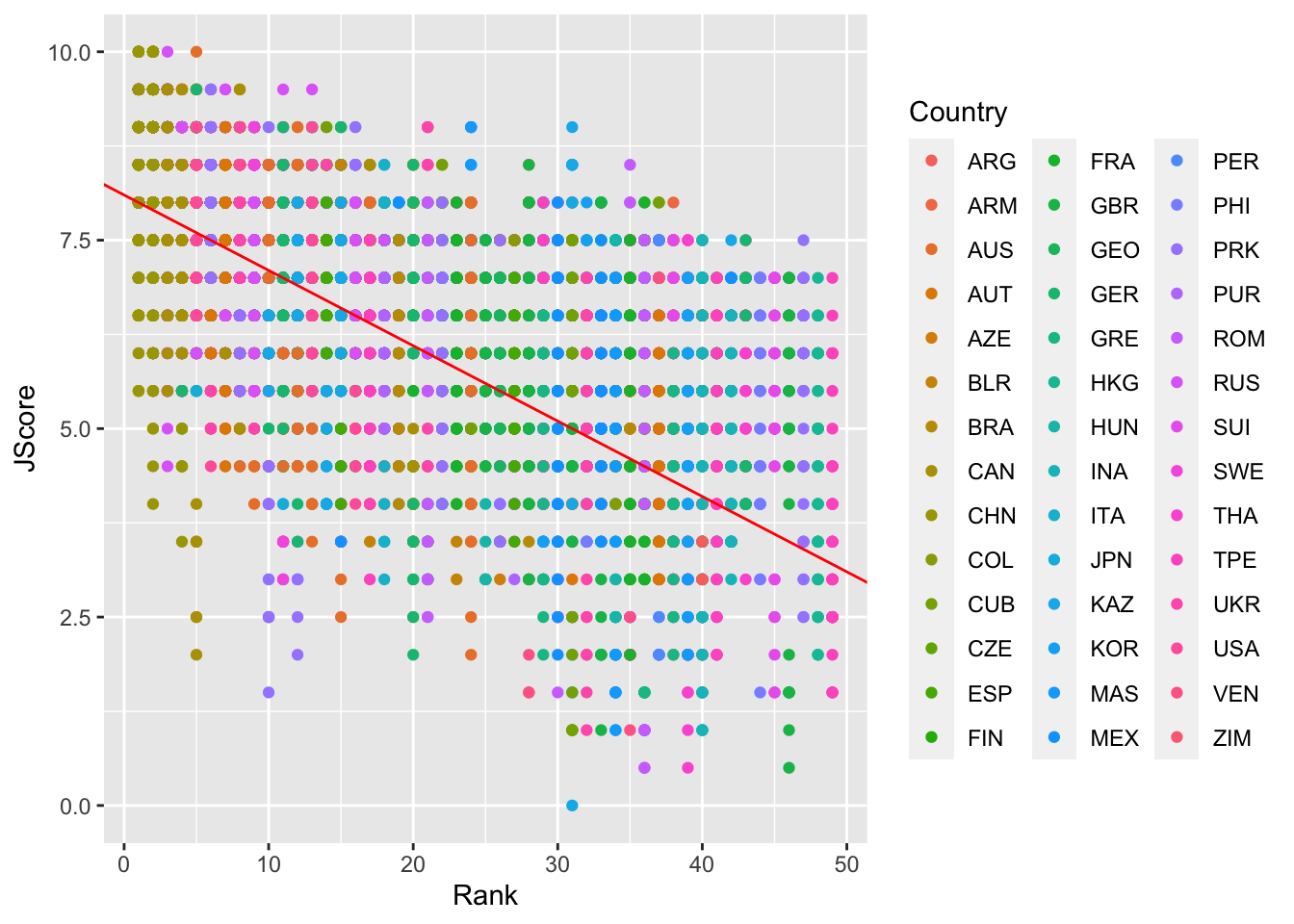
Note: geom_abline is different from
geom_line: geom_line “connects the dots”
between your data and so doesn’t have to be a straight line, whereas
geom_abline draws a straight line with the specified slope
and y-intercept. A common usage can be when comparing predictions to
actual values, where a line with slope 1 and intercept 0 indicates
perfect predictions.
Other geom for lines are:
geom_vline: to add a vertical line to a plotgeom_hline: to add a horizontal line to a plot
Stats
We can also specify a layer using stat_, which stands
for statistical transformation. This is useful if we want to plot a
summary statistic of our data, such as a mean or median. By using a
stat_ layer, we do not have to compute this summary
statistic beforehand–ggplot will compute the summary
statistic for us and then plot the result.
For example, suppose we want to plot the means of each judge’s score
and provide error bars of one standard deviation on either side of the
mean. We could use summarize and group_by to
find the mean and standard deviations for each judge, or we
could just use a stat_ layer!
The layer stat_summary() computes and then plots a
user-specified summary statistic. We choose the option
mean_se to calculate the means and standard deviations of
the scores of each judge.
As always, we set up the plot by calling ggplot,
specifying data = diving and then providing the
aes. In this case, we want the judge on the
x-axis and their scores on the y-axis. We then
add our stat_summary layer.
judges <- ggplot(data = diving, aes(x = Judge, y = JScore)) +
stat_summary(fun.data = mean_se) +
labs(y = "Judge Score")
judges
We can see that the judges’ names are bunched together… we can make
them much more readable by rotating the x-axis labels by 45 degrees
using the theme layer:

We can also completely flip the coordinates to make a horizontal plot!

Scales
Scales allow you to adjust the aesthetics or visual aspects of a plot. We return to the scatter plot of the judges’ scores vs rank of the divers. This time, we want to color the points by the difficulty of the dive.
We use the layer scale_color_distiller. The second word,
color, is the aes we want to change. We can
replace it with x, y or fill,
depending on the aes we want to change.
The third word is distiller, which we use because our
color variable, Difficulty, is continuous. If
it were discrete, we would write brewer instead.
scatter <- ggplot(data = diving_grouped) +
geom_point(aes(x = Rank_mean, y = JScore_mean, color = Difficulty_mean)) +
scale_color_distiller(palette = "OrRd", direction = 1)
scatter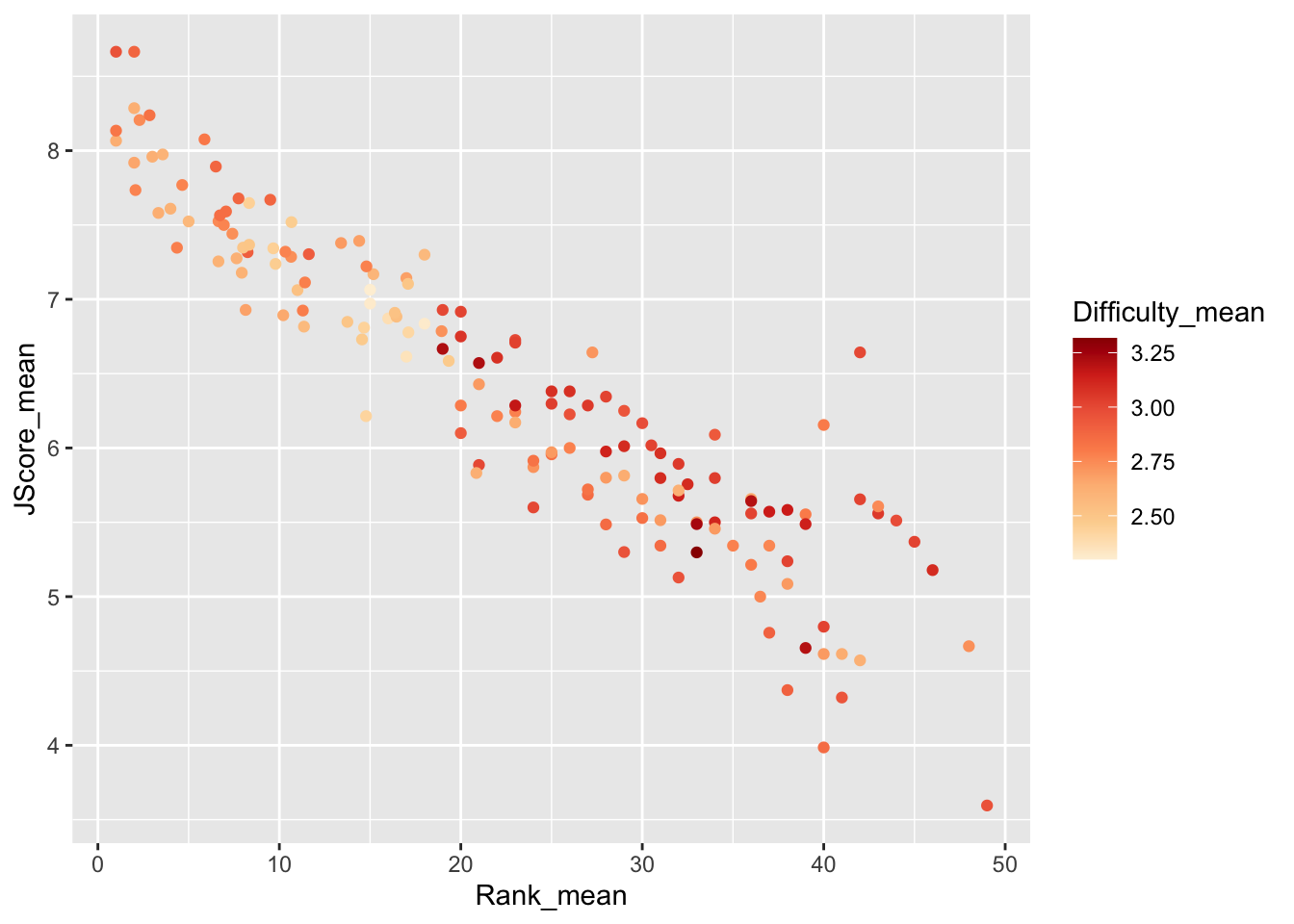
Interestingly, it seems that some of the highest ranked divers perform most of the less difficult dives, but perform these easy dives very well.
To further investigate, we plot a 2D histogram of Rank vs Difficulty.
hist <- ggplot(data = diving) +
geom_bin2d(aes(x = Rank, y = Difficulty), bins = 10) +
scale_fill_distiller(palette = "Spectral")
hist
Note that we use fill instead of color in
scale_fill_distiller to control the fill of the histogram
bins.
From the 2D histogram, we can see that the higher ranked divers attempt both more difficult and less difficult dives, unlike the lower ranked divers who only attempt more difficult dives.
ColorBrewer
The palettes used in this module, including “OrRd” and “Spectral”, come from ColorBrewer. You can take a look at the website and use some of these color palettes in your plots!
External Links
This ggplot guide is highly recommended to bookmark as a quick reference on how to plot virtually anything. It has multiple examples for each plot, each one going more in depth on specific ways to add information to a plot.
Additionally, you can access all the colors you’ve ever wanted with this alphabetical color guide to R colors!
Other Data Sources
So far in this course you’ve worked with data that we had already prepared for you. It turns out that there are many R packages and tools that you can use to get data from a variety of different sources. Below, we will provide a brief walkthrough of just a few of these resources.
Lahman
The Lahman Baseball Database is a popular resource created by Sean Lahman with historical data going back to 1871. Rather than having to access the database directly via complicated computing procedures, there is an R package we can install to access the data instead. The following code installs the package from the CRAN:
Next we load the package, and check out what datasets are available:
There is an incredible amount of data here going up through the 2021
season (it updates following the end of each season). As an example,
let’s access the Teams dataset, use a group_by operation to
calculate the number of strikeouts each year since 1871, and plot the
line over time:
Teams %>%
group_by(yearID) %>%
reframe(n_so = sum(SO, na.rm = TRUE)) %>%
ggplot() +
geom_line(aes(x = yearID, y = n_so)) +
labs(x = "Year", y = "Number of strikeouts",
title = "Total number of strikeouts in each baseball season since 1871",
caption = "Data courtesy of Lahman") +
theme_bw()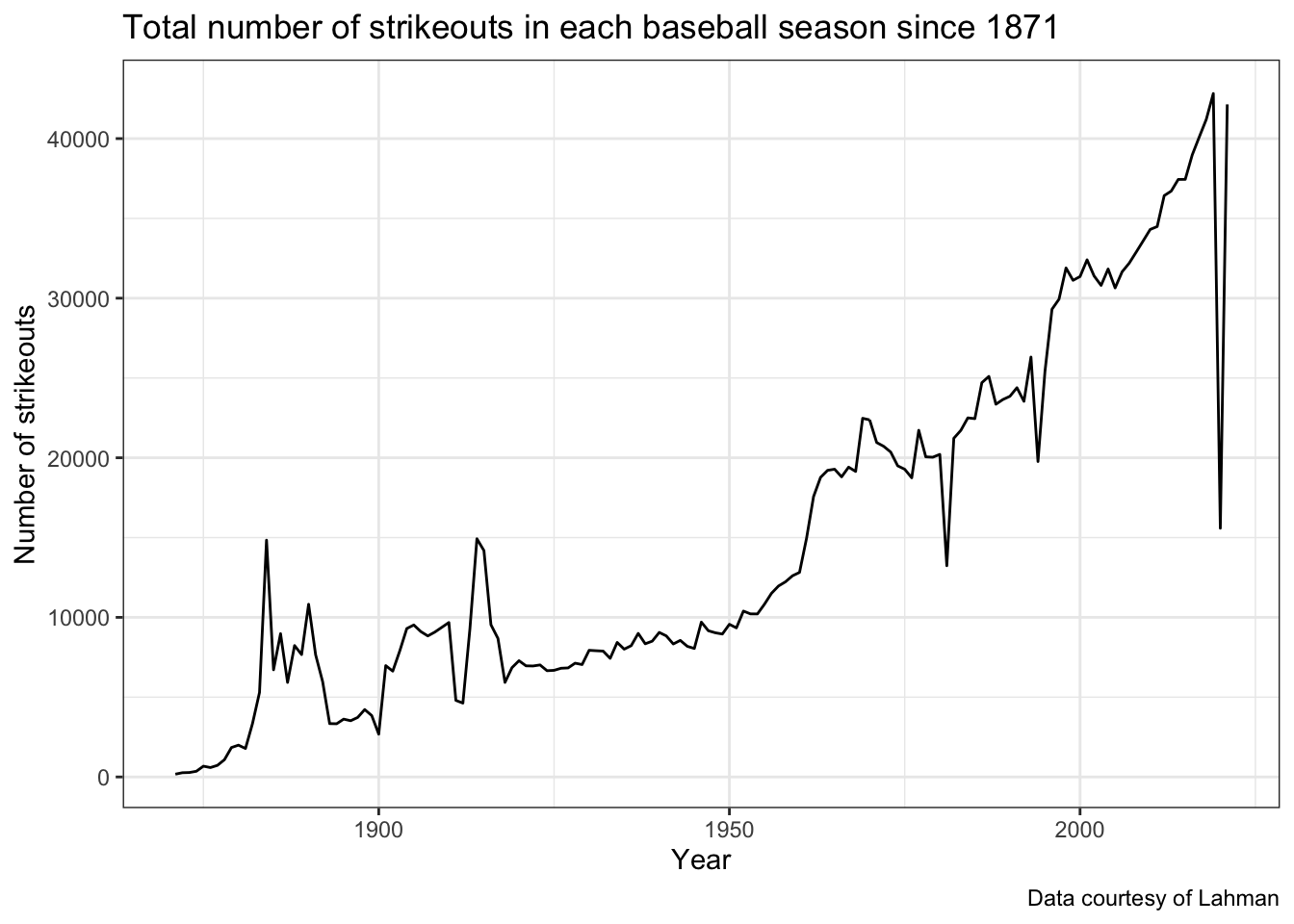
Note that rather than supplying the data as an argument to the
ggplot() function, we can start with a dataset, make
manipulations to it using pipes, and then pipe the new data into the
ggplot() function.
We can see the increasing trend over time, but note some of the outliers like 2020 (pandemic-shortened season) and 1994 (strike-shortened season). How could this display be improved to handle these outliers, as well as the other gameplay-related changes that have taken place in baseball?
nflfastR
The nflfastR
package gives R users the ability to scrape play-by-play data from
the NFL in real-time during games, also providing expected points and
win probability estimates. Here’s a good
tutorial on the main functions and data available within the
package. To get started, we install the package below. Let’s also
install the ggimage package, which will allow us to plot
the team logos for more intriguing visualizations.
Next, we load these packages.
Now we can use nflfastR to gather play-by-play data for
the 2021 season.
With this data, we can summarize the performance of all NFL teams using the expected points added (EPA) per game on offense and defense. EPA tells us how much value the team provided relative to an average baseline. The more positive the better the offensive performance. This means the more negative the value the defensive performance, so in the code chunk below we multiply the defensive values by -1 so it’s similar to offensive performance higher values meaning better performance. The following code uses this data to create offensive and defensive summaries that we will join together to plot:
offense_epa_21 <- pbp_2021 %>%
filter(!is.na(posteam)) %>%
group_by(posteam) %>%
summarise(n_games = length(unique(game_id)), off_total_epa = sum(epa, na.rm = TRUE)) %>%
mutate(off_epa_per_game = off_total_epa / n_games)
defense_epa_21 <- pbp_2021 %>%
filter(!is.na(defteam)) %>%
group_by(defteam) %>%
summarise(n_games = length(unique(game_id)), def_total_epa = sum(epa, na.rm = TRUE)) %>%
# This time multiply by -1, since negative values are better for defense:
mutate(def_epa_per_game = -1 * def_total_epa / n_games)Next, we join together the offensive and defensive EPA datasets, then
pass this new dataset into ggplot, where we make a plot of
offensive EPA per game vs. defensive EPA per game for all teams in the
2021 season.
# Create the data frame to be used for all of the charts:
offense_epa_21 %>%
inner_join(defense_epa_21, by = c("posteam" = "defteam")) %>%
left_join(teams_colors_logos, by = c("posteam" = "team_abbr")) %>%
ggplot(aes(x = off_epa_per_game, y = def_epa_per_game)) +
geom_image(aes(image = team_logo_espn), size = 0.05) +
labs(x = "Offensive EPA per game",
y = "Defensive EPA per game",
caption = "Data accessed via nflfastR",
title = "Offensive and defensive EPA per game for each team in the 2021 NFL season") +
# Add reference lines at 0
geom_hline(yintercept = 0, color = "red", linetype = "dashed") +
geom_vline(xintercept = 0, color = "red", linetype = "dashed") +
theme_bw()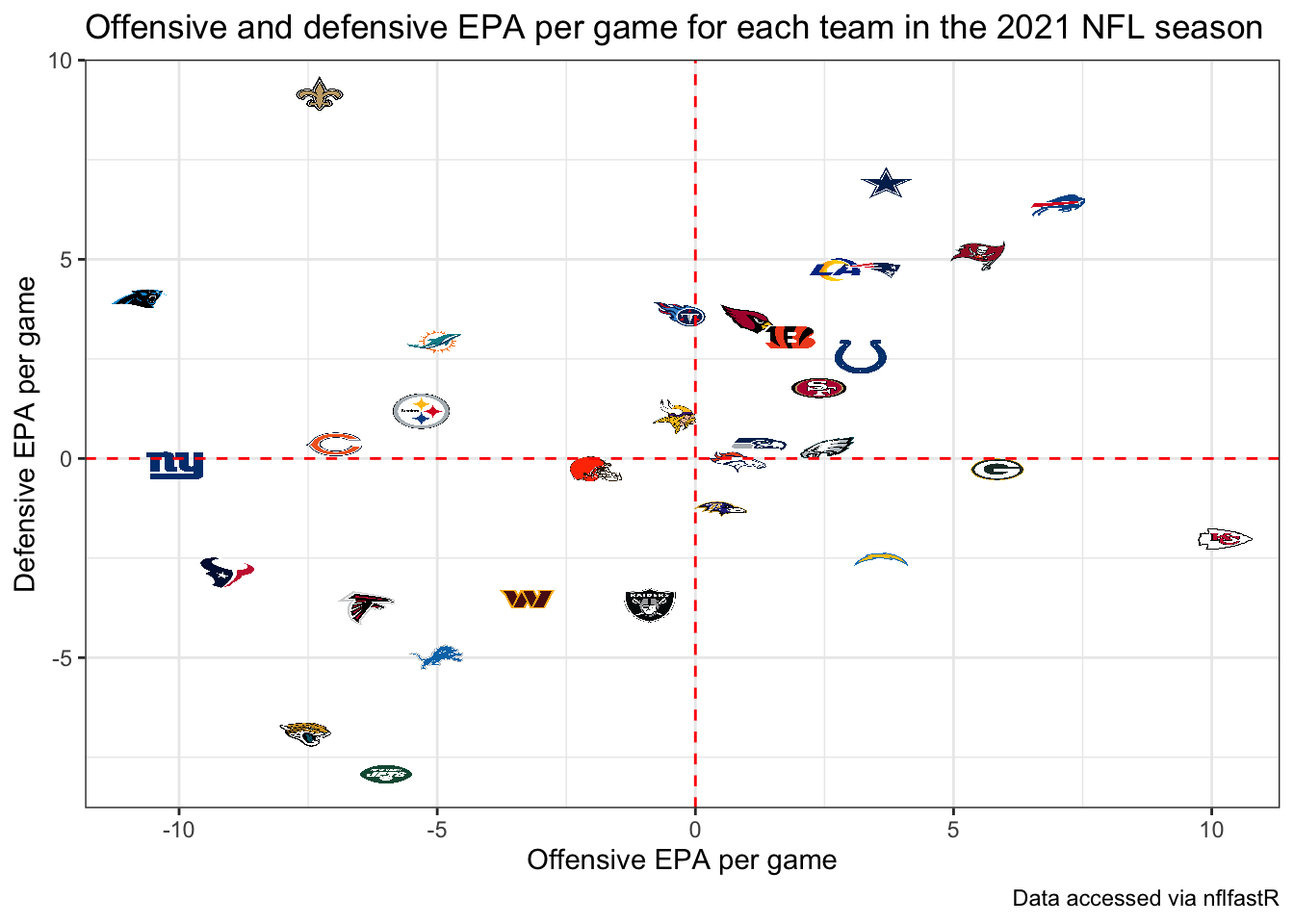
The top right displays the teams that excelled at both offense and defense, while the lower right shows teams that had the best offenses such as the Chiefs but performed poorly on defense. The lower left shows the worst overall teams, where the Jags, Jets, and Texans unsurprisingly stand out.
Installing GitHub Packages
While the vast majority of R packages you will commonly
use are able to be installed using install.packages()
because they are on the CRAN, there are a variety of popular
R packages for accessing sports data that are currently
only available through GitHub. In order to access these packages, we
first need to install them using a package called devtools.
The code below installs the devtools package:
The devtools package has a function,
install_github that we will use for installing the
remaining packages used below.
An important note to keep in mind is that most of these resources are largely still in development, so you may face challenges with installation and use.
baseballr
Created by Bill
Petti, the baseballr package has become a popular
resource for accessing baseball data from variety of resources, such
asFanGraphs and Baseball-Reference
directly into R. One of the best features of the
baseballr package is the functionality it provides us for
directly accessing the publicly available pitch-by-pitch and Statcast
data available from baseball-savant.
We first install the package using the devtools package
explained above, and then load its functions:
Using the baseballr package we can access all pitches
thrown to a hitter in the current season, giving us Statcast data like
exit velocity and launch angle. We first use the
playerid_lookup function to find the Statcast ID for
Yankees star (and potential AL MVP) Aaron Judge:
This will load up a look-up table with all identifiers joining
various sources together (it may take a couple minutes to run and don’t
worry about the warning messages). We find that Aaron Judge’s unique
mlbam_id is 592450. Using this id, we can grab all pitches
thrown to Judge in the current MLB season so far:
judge_statcast_data <- scrape_statcast_savant_batter(start_date = "2022-01-01",
end_date = "2022-12-31",
batterid = 592450)This dataset contains many columns; for now we will look at the
relationship between the distance traveled of Aaron Judge’s batted balls
(denoted by type == "X") and the launch angle
(launch_angle) as well as the exit velocity
(launch_speed):
judge_statcast_data %>%
filter(type == "X") %>%
ggplot(aes(x = launch_speed, y = launch_angle,
color = hit_distance_sc)) +
geom_point() +
scale_color_viridis_c(option = "A") +
labs(x = "Exit velocity (MPH)", y = "Launch angle (degrees)",
color = "Distance (feet)",
title = "Aaron Judge's launch angle, exit velocity, and distance traveled",
caption = "Data accessed via baseballr")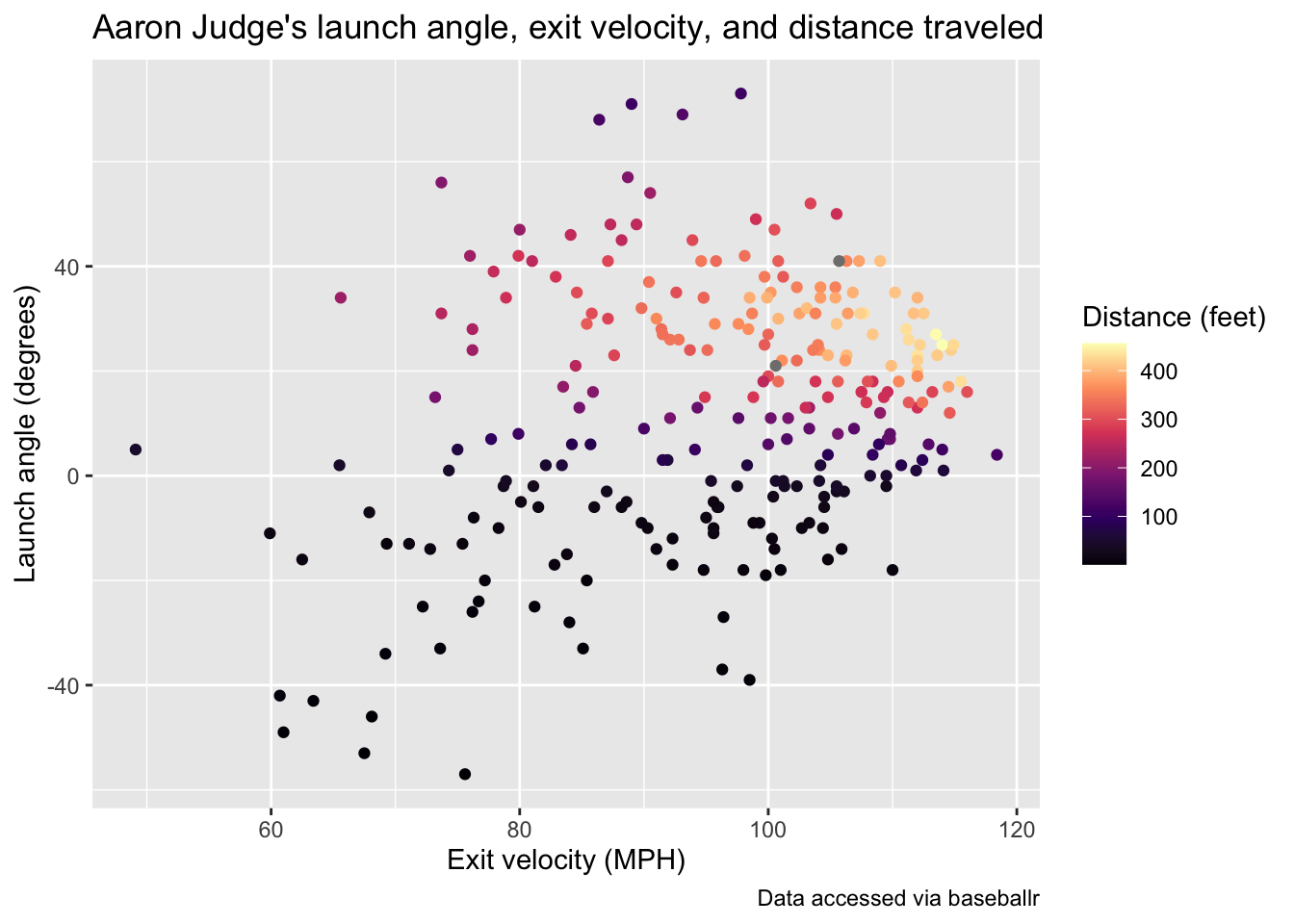
Note that this plot has been updated through July 15th of the 2022 season. Pitches thrown to Judge after this date will not appear on the above plot.
This is just a single example of the type of data available using
baseballr. See the package website for more data
acquisition functions. Additionally, the Exploring Baseball Data with
R website by Jim Albert is an incredible resource with a variety of
examples of learning R code all in the context of baseball data
analysis.
nbastatr
The nbastatr
package created by Alex Bresler is analogous to the
baseballr package as it provides many different functions
for accessing NBA data from a variety of websites. Again to be able to
use the package you need to install it from GitHub:
There will likely be several messages that appear when installing this package, please let us know if you encounter any strange issues. The code below demonstrates how to get all shot attempts by the 2022 NBA champions, the Golden State Warriors, in the past season using this package:
Using this shot data, we can view the all shot attempts by the Warriors throughout the season colored by whether or not they made the shot.
warriors_shots %>%
ggplot(aes(x = locationX, y = locationY, color = isShotMade)) +
geom_point(alpha = 0.5) +
scale_color_manual(values = c("#FFC72C", "#1D428A")) +
theme_bw() +
labs(title = "Shot attempts by Golden State Warriors in 2021-22 NBA season",
caption = "Data accessed via nbastatR")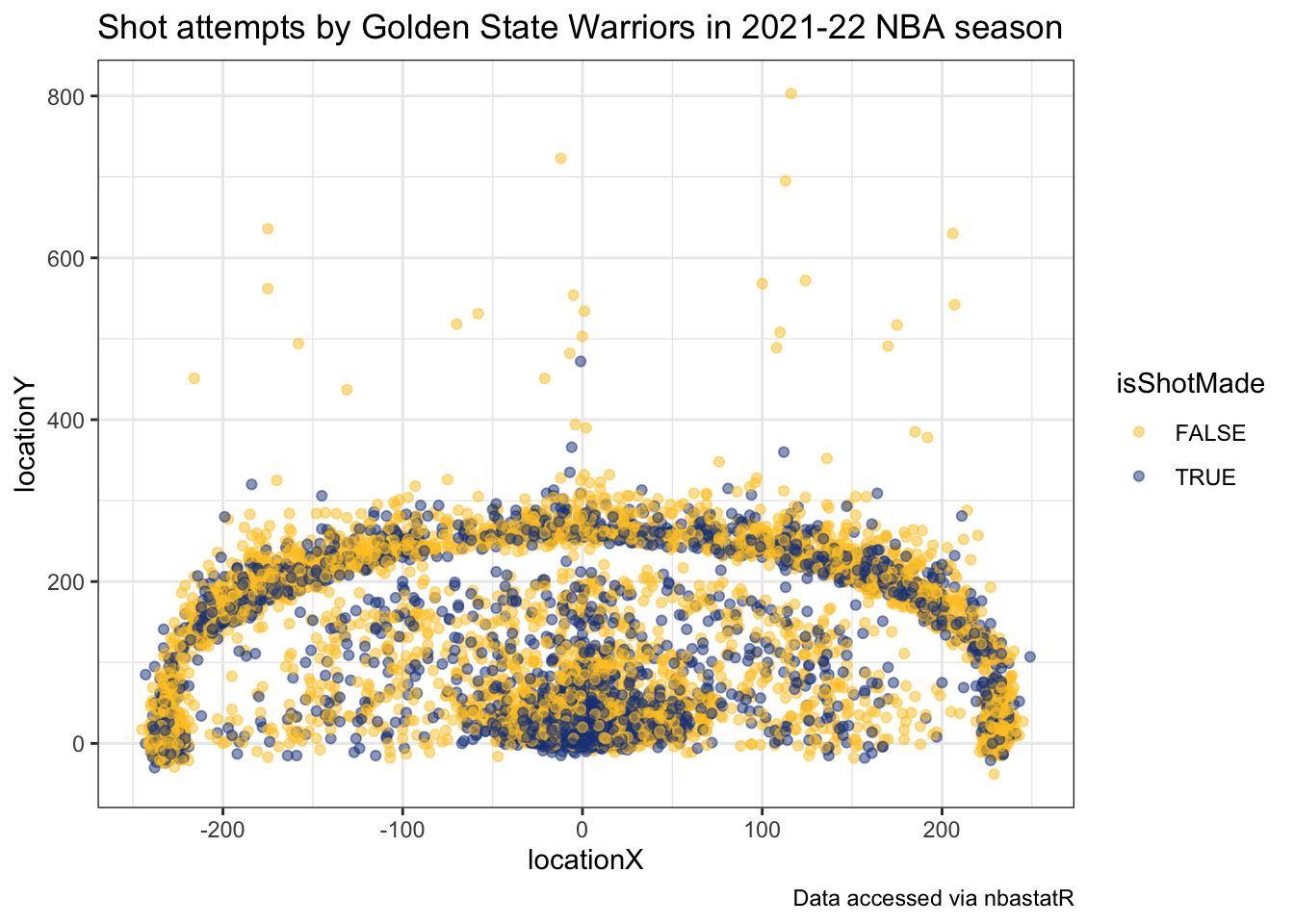
It’s apparent from this chart the effect of the three-point line of their shot selection.
